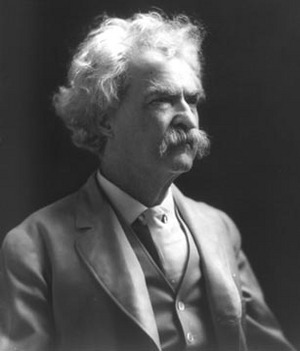American author Mark Twain was called the “Father of American Literature” by William Faulkner and it was a title well deserved. With classic tales like The Adventures of Tom Sawyer and Adventures of Huckleberry Finn, Twain set the standard for childhood adventure.
Mark Twain was born Samuel Langhorne Clemens on November 30, 1835 in Florida, Missouri. While he was the sixth of seven children, he was one of only four to survive childhood. The family moved to Hannibal, Missouri when Twain was four years old. The town sat on the banks of the Mississippi River, which would play a major part in many of Twain’s tales. Slavery was still legal in Missouri at this time as well and it too would be a theme Twain explored in his writing.
Twain briefly left Hannibal for New York City after his father died and he began work as a printer’s apprentice. However, he returned to Hannibal at the age of 22. After a trip down the Mississippi, Twain was inspired to become a steamboat pilot, a very rewarding occupation in that day. He earned his license in 1859 and convinced his brother Henry to work with him. Unfortunately, Henry was killed in a steamboat explosion. Twain carried the guilt of his brother’s death with him throughout his life.
Twain continued on as a steamboat pilot until the Civil War broke out in 1861 and traffic on the Mississippi dwindled. He traveled westward in a stagecoach with his brother Orion, briefly working as a miner, before ending up in San Francisco. It was in San Francisco where Twain would begin working as a journalist. The Celebrated Jumping Frog of Calaveras County was published in the New York Saturday Press in 1865, bringing Twain national attention.
In 1870, Twain married his wife, Olivia, who exposed him to new ideas including abolition, women’s rights and social equality. From 1869 until 1871, the couple lived in Buffalo, New York, but after their son’s death, the family moved to Hartford, Connecticut. Although a southerner by birth, Twain would spend the next 17 years in Connecticut, writing some of his most popular works. The Adventures of Tom Sawyer may have been written in Connecticut, but the setting of the novel was pure Missouri, as was Adventures of Huckleberry Finn and Life on the Mississippi. He would use the character Tom Sawyer not only in the original novel and in Adventures of Huckleberry Finn, but also in Tom Sawyer Abroad and Tom Sawyer, Detective. The Tragedy of Pudd’nhead Wilson was about a young lawyer in a fictional Missouri town.
Not all of Twain’s writings were centered on southern life. He wrote The Prince and the Pauper about a pauper in the Offal Court in London and was his first attempt at historical fiction. His 1880 novel, A Tramp Abroad, described his second trip to Europe. Twain’s 1889 novel, A Connecticut Yankee in King Arthur’s Court, tells the story of Hank Morgan, a Connecticut Yankee who finds himself magically transported back to the time of King Arthur.
Twain was quite the celebrity during his lifetime. He was friends with Helen Keller, oil executive Henry H. Rogers, scientist Nikola Tesla, journalist Ida M. Tarbell, educator Booker T. Washington, several U.S. presidents, and European royalty. During his lifetime, Twain became know for many of his witty quotes including, “I have never let my schooling interfere with my education,” “It’s not the size of the dog in the fight, it’s the size of the fight in the dog,” “It is best to keep your mouth shut and be presumed ignorant than to open it and remove all doubt,” and “Golf is a good walk spoiled.
Twain was born only two weeks after the closest approach of Halley’s Comet, which returns every 75-76 years. He predicted that because he came in with the comet, he would also go out with it. Oddly enough, he did just that. Twain died on April 21, 1910, just a day after Halley’s Comet’s closest approach to the Earth.



